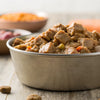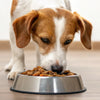Why Won’t My Dog Eat Wet Food? Understanding the Reasons Behind Your Dog's Food Refusal
- Houndsy
Table of Contents
- Introduction
- Why Won't My Dog Eat Wet Food? Common Causes Explored
- Practical Tips to Encourage Wet Food Eating
- When to Seek Veterinary Care
- The Role of Feeding Innovation: How Houndsy Elevates Mealtime
- Bringing It All Together: Understanding and Responding to Your Dog’s Refusal to Eat Wet Food
Introduction
Have you ever set down a flavorful bowl of wet dog food only to see your furry friend give it the cold shoulder? This perplexing scenario is one that many devoted dog owners face, and understandably so—seeing our pets refuse food can stir up a swirl of worry regarding their health and happiness. In fact, studies suggest that as many as 5-10% of dogs experience sudden changes in their eating habits at various stages of their lives. This common question—"Why won’t my dog eat wet food?"—is significant as it can indicate a range of underlying issues, from trivial preferences to serious medical concerns.
As pet parents, it becomes crucial to understand the reasons behind such behavior. In this blog post, we’ll take an in-depth look at the various factors that could lead to your dog refusing wet food and offer practical strategies to rekindle their appetite. By the end, we hope you’ll feel equipped to address the issue effectively and confidently, turning mealtime back into a joyful experience for both you and your canine companion.
Let’s dive deep into the world of doggy dining and help you understand what could be causing your pooch to turn their nose up at wet food.
Why Won't My Dog Eat Wet Food? Common Causes Explored
When a dog refuses to eat wet food, the reasons can be complex, intertwining health, behavioral, and environmental aspects. It’s essential to investigate multiple facets of your dog’s life to gain a clearer understanding.
1. Health-Related Causes
Loss of appetite in dogs can often signal underlying health issues. If your dog shows a marked reluctance to eat their wet food, consider the following possibilities:
Illness and Pain
A sudden loss of appetite could stem from dental pain or gastrointestinal discomfort. Dogs suffering from conditions like gastritis, pancreatitis, or infections may find even the soft texture of wet food unappealing. For instance, a dog with a dental abscess might refuse wet food due to pain, as chewing—even if it is soft—can be uncomfortable.
Example: Take Bella, for instance, a dog who usually devoured every meal. When she suddenly rejected her wet food, a veterinary visit revealed she had a dental abscess causing her mouth pain. Following treatment, Bella's appetite bounced back.
Medication Side Effects
Some medications may lead to a decreased appetite. Drugs like antibiotics or painkillers can disrupt your dog’s usual eating patterns, potentially making them indifferent to their food.
Gastrointestinal Issues
If your dog is experiencing stomach problems like gurgling, vomiting, or diarrhea along with refusing to eat, this indicates a possible gastrointestinal upset. In such cases, reaching for bland diet alternatives, like boiled chicken or rice, while seeking veterinary advice is essential.
2. Behavioral and Emotional Factors
Dogs, much like humans, wrestle with emotions and can exhibit changes in behavior based on their feelings.
Anxiety and Stress
Situations like changes in the household, moving, or even loud noises (such as fireworks or thunderstorms) can trigger anxiety in dogs, impacting their willingness to eat. Dogs experiencing stress may reject their food only to eagerly consume treats, showcasing their selective eating.
Picky Eating Habits
Just as humans have food preferences, dogs can develop specific likes and dislikes. A dog used to dry kibble might find wet food unfamiliar or unappealing. Additionally, dogs that have been spoiled with treats and table scraps may learn to hold out for more appealing options.
Environmental Factors
A disruptive feeding environment can deter your dog from eating. Factors such as noise levels, distractions, or food bowls sliding across the floor can negatively impact their appetite.
3. Changes in Feeding Routine and Environmental Factors
Proper management of your dog's feeding routine can aid in establishing a consistent appetite.
Overfeeding and Excess Treats
Grazing on treats throughout the day may leave your dog unmotivated to eat during mealtime. Overindulgence can skew their daily caloric intake, leading to an unbalanced diet and selective eating habits.
Freshness and Changes in Food Formula
Sometimes, changes in your dog's favorite wet food formula may cause them to turn away from it. If the recipe has altered significantly, their palate might not be suited for the new flavor profile. Similarly, wet food that is stale or improperly stored may lose its appeal, making it less inviting.
Feeding Environment Adjustments
Consider whether your dog feels comfortable during mealtimes. Creating a calm, quiet space for feeding can counteract anxiety and improve appetite. Experiment with non-slip bowls or different locations in your home to find the ideal spot.
Practical Tips to Encourage Wet Food Eating
Understanding the reasons behind your dog’s refusal is a key first step. The next challenge is how to encourage them to eat. Here are several actionable tips to help coax your dog into enjoying their wet meals again:
1. Ensure Food Freshness and Appeal
- Check Expiration Dates: Always examine the date on tin or pouch packaging.
- Proper Storage Conditions: Store wet food in a cool, dry place and keep opened containers tightly sealed.
- Warm the Food: Heating the food to body temperature can enhance its aroma, making it more appealing to your dog.
- Add Toppers: Improve wet food taste by mixing in healthy toppers or broth (avoid salt or onions).
2. Gradually Transition Foods
If your dog is used to dry kibble, slowly introducing wet food by mixing it into their regular meals can ease the transition. This gentle acclimatization to the new texture may make it more enjoyable for them.
3. Maintain Consistent Feeding Routines
Sticking to specific feeding times and avoiding free feeding can help regulate appetite and encourage consistent eating.
4. Limit Treats and Snacks
To maintain a healthy appetite, ensure treats and snacks makeup no more than 10% of your dog's total caloric intake. This encourages your dog to eat their actual meals.
5. Create a Comfortable Feeding Space
Evaluate your dog’s feeding area. It should be quiet, calm, and free from distractions to foster positive mealtime experiences.
6. Hand Feeding and Positive Reinforcement
Offering food by hand occasionally, paired with praise, can rekindle a sense of excitement during meals, reinforcing a positive association with feeding times.
7. Elevate Feeding Experience with Well-Designed Tools
Incorporating functional and ergonomically-designed products—like the Houndsy Kibble Dispenser—can further enhance the feeding experience. With its convenient crank feature, perfect portion control, and stylish design, the Houndsy Kibble Dispenser transforms mealtime into both a delightful and stress-free experience for dogs and owners alike. Explore the Houndsy Kibble Dispenser today to witness the difference for yourself!
When to Seek Veterinary Care
While occasional pickiness is normal, some signs warrant immediate veterinary attention, including:
- Refusal to eat wet food for more than 24-48 hours.
- Additional symptoms, such as vomiting, diarrhea, excessive lethargy, or weight loss.
- Sudden changes in behavior alongside appetite loss.
- Signs of pain or discomfort when eating.
Prompt veterinary consultation will ensure that any underlying health concerns are effectively addressed and treated, keeping your furry friend healthy and happy.
The Role of Feeding Innovation: How Houndsy Elevates Mealtime
At Houndsy, we’re dedicated to simplifying and enhancing the everyday feeding experience for dog owners everywhere. Our flagship product, the Houndsy Kibble Dispenser, is designed creatively to address common challenges in dog feeding:
- Ergonomic Convenience: The convenient crank operates at standing height, reducing the need to bend over.
- Perfect Portion Control: Allows for the dispensing of precise amounts consistently, aiding in balanced diets.
- Large Storage Capacity: Holds 25–30 lbs of food while the BPA-free liner ensures freshness.
- Auto-Locking Mechanism: Prevents accidental spills or unwanted access by pets or toddlers.
- Mid-Century Modern Design: Enhances the aesthetic of your living space, proving functionality can coexist beautifully with style.
Investing in well-designed feeding tools means you can transform mealtime from a chore to an enjoyable ritual, ensuring your dog relishes every meal in comfort.
Bringing It All Together: Understanding and Responding to Your Dog’s Refusal to Eat Wet Food
The reasons for your dog’s refusal to eat wet food can range from simple preferences to complex health challenges. By observing their behavior, making thoughtful adjustments to feeding routines, and consulting with your veterinarian when necessary, you can support their nutrition and overall well-being.
Feeding dogs should not be a stressful or messy affair. With innovative products like the Houndsy Kibble Dispenser, you can introduce convenience, consistency, and elegance into your feeding rituals. This dual focus benefits both your pet's enjoyment and your peace of mind.
Are you ready to transform your dog’s feeding experience? How do you currently manage mealtimes, and what challenges have you faced? It might be time to explore solutions designed with both dogs and their humans in mind.
FAQ
Q1: Is it normal for dogs to reject wet food sometimes?
Yes, occasional rejection can occur due to mood shifts, temporary illnesses, or changes in appetite. However, persistent refusals should be investigated further.
Q2: Can I feed my dog only wet food or only dry food?
While many dogs tolerate being fed exclusively wet or dry food, a balanced diet generally combines both. Consulting your vet can provide tailored insights for your specific dog.
Q3: How can I tell if my dog’s refusal to eat wet food is health-related?
Watch for additional symptoms such as lethargy, vomiting, diarrhea, or hints of pain while eating. Sudden appetite changes warrant a vet visit.
Q4: Should I mix wet and dry food to entice my picky dog?
Yes, mixing wet and dry food can increase meal appeal. Gradually reducing wet food can encourage acceptance of dry kibble over time.
Now that we’ve unpacked the intricacies of why your dog may refuse wet food, it’s time to explore practical solutions that nourish and delight your furry friend. If you find yourself continuously struggling with feeding your dog, consider adding innovative tools like the Houndsy Kibble Dispenser to transform feeding times. Order your Houndsy Kibble Dispenser today. Your dog’s next meal awaits!












